Kingston HyperX Cloud Core. Removing excess

At present, Kingston is monitoring the rapidly developing peripheral market, releasing suitable devices (at the moment - headsets and rugs), gradually grabbing part of the market. I personally observe how the line of gaming headsets is gaining popularity, as many advise it when choosing a headset in terms of price / quality ratio.
The new Kingston HyperX Cloud Core headset is the youngest model in the entire line. And the cheapest, by the way. But this does not mean that the sound quality has suffered. On the contrary, Kingston decided simply - we’ll leave usable sound in the headphones, the same microphone, and remove all unnecessary equipment — equipment. That is, the same quality of sound and voice transmission is declared as in the previous models of the line.
But how will this headset prove itself and who is it aimed at? What exactly is the gaming headset chip? Let's try to figure it out. 2 audio samples recorded from a microphone are included.
Content:
All images in the text have a high resolution.
Introducing the headset [ ↑ ]
First, I decided to write all the technical characteristics of the ears, because not all information is indicated everywhere (resistance and microphone characteristics, for example), but as it turned out, you do not have to go far, and all the information is already available in the announcement of this headset . So a full description of all the characteristics of the headset is given by reference, but I suggest focusing on studying it.
Where did these headphones come from? A bit of analytics
In fact, just a huge line can be traced. Studying this question, I was even a little confused, because Kingston headphones are not their own development, but an OEM product that is very well redesigned. The headphones themselves originate in the QPad QH-90 headset, however, QPad is an OEM product. Most likely, their predecessor was the Takstar Pro 80 headphones. Just QPad removed the gloss from the cups and screwed the microphone, which made the headphones a headset, moreover, more unpretentious in care. But there is information that ... OEM Headphone Takstar Pro 80 - Gemini DJ HSR-1000.
This chain can stretch very far, but they all borrow something from each other and it is quite difficult to find a beginning. Information for mere mortals is most likely unavailable, so only speculation remains. In addition, if you look closely at the shape of the cup mounts, then only one company comes to mind - Beyerdynamic. In my opinion, they were the first in their DT 770/880/990 lines to use such a mount (in the form of a slingshot), it turned out to be successful and very reliable, so the rest decided to “borrow” it. I see nothing wrong with that. These are just my observations that do not claim to be true. If you look at the same QPad QH-1339 headset, you will see how strikingly they look like the Beyerdynamic DT 770 Pro headphones or the Beyerdynamic DT 790.00 headset.
The difference in the sound of any Cloud, Takstar, QPad and others, most likely, will be insignificant (or it won’t exist at all), since the same speakers are probably there. Unless markings and revisions may differ, but structurally the speakers will be similar. Or maybe all the speakers come from the same factory. Moreover, from a dialogue with one person who is keenly interested in peripherals and owns Takstar Pro 80 headphones, I found out that the sound of the HyperX Cloud and Takstar Pro 80 is identical (judging by the description). I will talk about the sound later, it's just a kind of confirmation of my observations.
So why exactly HyperX Cloud? Everything is simple. Takstar and the same Gemini are generally just headphones without a microphone, besides quite easily soiled and at a price comparable to HyperX Cloud Core, QPad are not sold in Russia, so this is a reasonable option in a pair of headphones + microphone.
This chain can stretch very far, but they all borrow something from each other and it is quite difficult to find a beginning. Information for mere mortals is most likely unavailable, so only speculation remains. In addition, if you look closely at the shape of the cup mounts, then only one company comes to mind - Beyerdynamic. In my opinion, they were the first in their DT 770/880/990 lines to use such a mount (in the form of a slingshot), it turned out to be successful and very reliable, so the rest decided to “borrow” it. I see nothing wrong with that. These are just my observations that do not claim to be true. If you look at the same QPad QH-1339 headset, you will see how strikingly they look like the Beyerdynamic DT 770 Pro headphones or the Beyerdynamic DT 790.00 headset.
The difference in the sound of any Cloud, Takstar, QPad and others, most likely, will be insignificant (or it won’t exist at all), since the same speakers are probably there. Unless markings and revisions may differ, but structurally the speakers will be similar. Or maybe all the speakers come from the same factory. Moreover, from a dialogue with one person who is keenly interested in peripherals and owns Takstar Pro 80 headphones, I found out that the sound of the HyperX Cloud and Takstar Pro 80 is identical (judging by the description). I will talk about the sound later, it's just a kind of confirmation of my observations.
So why exactly HyperX Cloud? Everything is simple. Takstar and the same Gemini are generally just headphones without a microphone, besides quite easily soiled and at a price comparable to HyperX Cloud Core, QPad are not sold in Russia, so this is a reasonable option in a pair of headphones + microphone.
Acquaintance begins with a big box. The black box is inside the sleeve of thick glossy cardboard. The sleeve is made in black and red, on the sleeve itself there is an image of the headphones and various information is located on all sides. On the front are the main characteristics, on the sides are the features and names of the organizations that use this headset, on the back are a more detailed description of all the ear chips and information on the Kingston two-year warranty. I will not read this, there is nothing super important there.
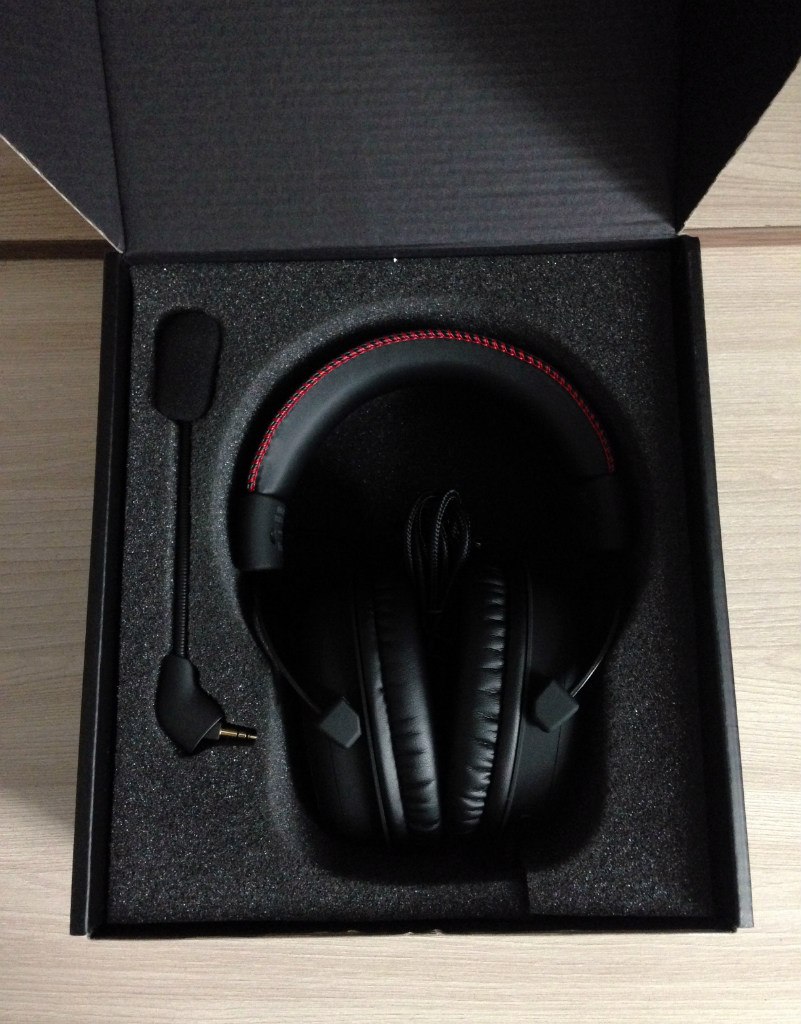
There are no inscriptions on the black cardboard box, and the box itself has a simple hinged lid. Unlike the first Cloud model, there is nothing at all on the box - no inscriptions, no greetings on the lid inside. Here, too, they removed everything superfluous. Two pieces of paper fall out of the box at once - one with support and sites (useless) and a piece of paper with connection to various devices (more or less useful, illustrated). Inside, everything is studded with foam for the safety of headphones and accessories.
Here is all the equipment that turned out to be extremely scarce - headphones, a microphone and an adapter with a 4-pin 3.5 mm jack to a 2x 3.5 mm jack for separately connecting the headphones and microphone to the motherboard on a computer or external sound card, for example. No extra velor ear pads that came with the first Cloud, no carrying bag. Headphones, microphone and extension adapter. That's all the equipment. Few, extremely few. But it will be appreciated by those who do not need all sorts of bells and whistles, and the Cloud Core headset is the most budgetary in the entire line.
I had a double impression: on the one hand, it really is not really necessary, but on the other ... All adapters are easily bought on the electronics market, and you can even choose any length of adapters, but find a good bag for headphones or a new pair of ear pads it will be difficult. Will have to turn to Chinese colleagues with their famous stores. And given the fact that the family of headphones with this shape of the cups is quite popular (see spoiler above), it’s not difficult to purchase such ones.
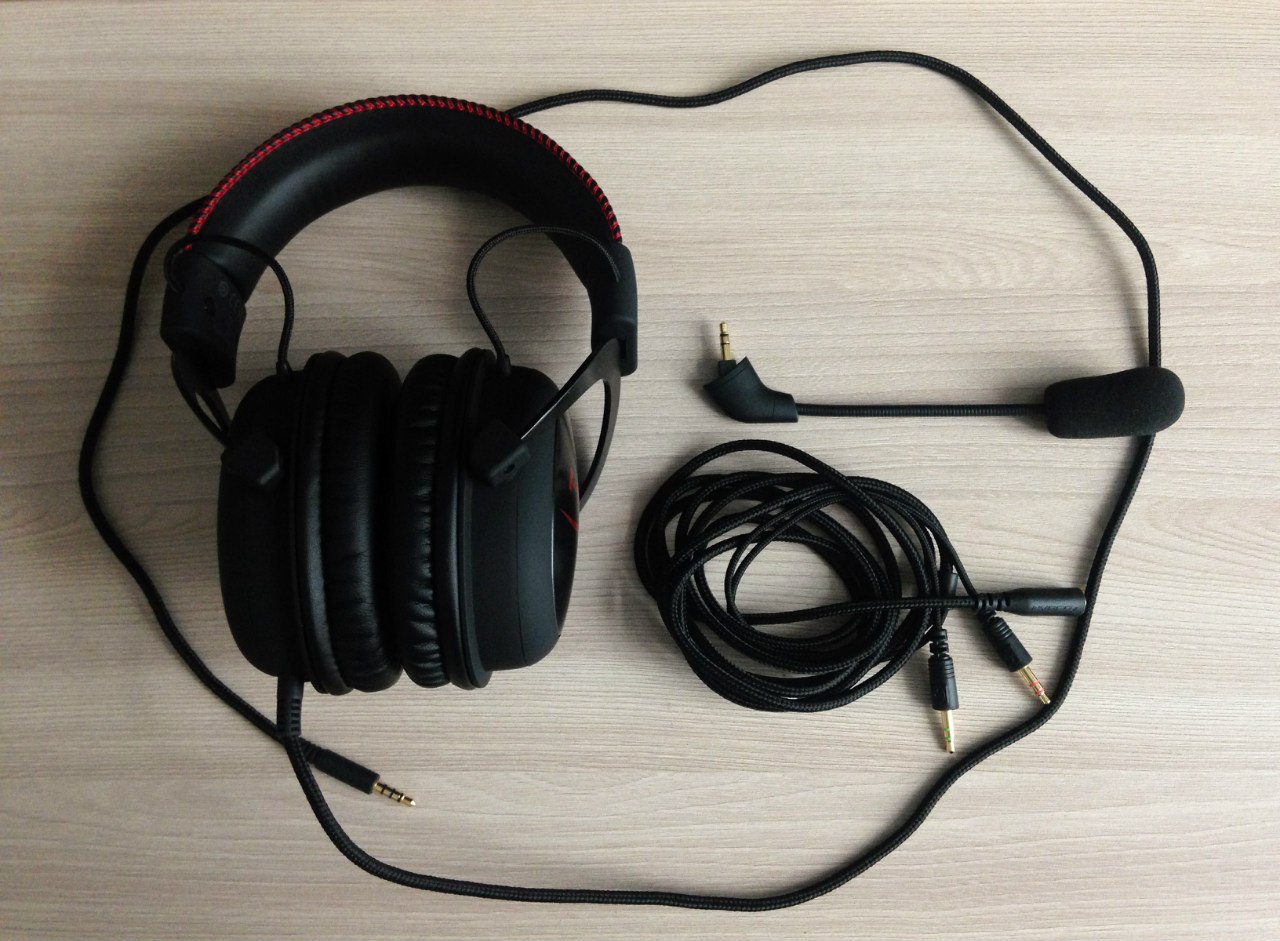
What are the differences from other headphones in the HyperX Cloud line?
Compared to the first headset, the headphones have one wire 1.1 meters long, ending with a 4-pin 3.5 mm jack-ohm, while the first at the end originally had two wires - one for the ears and one for the microphone; also the first Cloud had much more equipment. In comparison with Cloud II, the headphones and microphone themselves are no different (the noise canceling nozzle has a slightly different shape, this does not affect the voice transmission), however, Cloud II comes with a sound card that allows the headphones to work through USB, and it also supports virtual 7.1 sound mode. About 7.1, I will then separately say a few words, but everything else is the same. That is, there are no differences in the headphones themselves and the microphone at all. All that has changed is the equipment, colors and, of course, the price. Well, there’s also a single wire for the headphones themselves in Cloud II and Cloud Core,
Design and ergonomics [ ↑ ]
The first thing that is felt after you take the headphones out of the box is the smell. Light smell of novelty, pleasant, noble. Headphones covering, the ear creeps into them completely - I like this type of headphones the most. The microphone attaches on the left side next to the cable (you must first remove the plug from the microphone connection jack). It is inserted there tightly, from there it will not jump out anywhere.

The headphones themselves are made in black and gray-red. Moreover, the gray color is also quite dark, so the coloring turned out to be strict and neat, with red accents in the form of the HyperX logo on the ear cups and a red line on the headband. The aluminum parts are painted black - the sides of the cups and the aluminum arms on which these cups are attached. The material of the cups themselves is soft-touch coating. The place where the headphone arms come in is done very carefully, no distortions, everything is very well fitted. The material for fixing the entrance to the cups is also a soft touch coating.
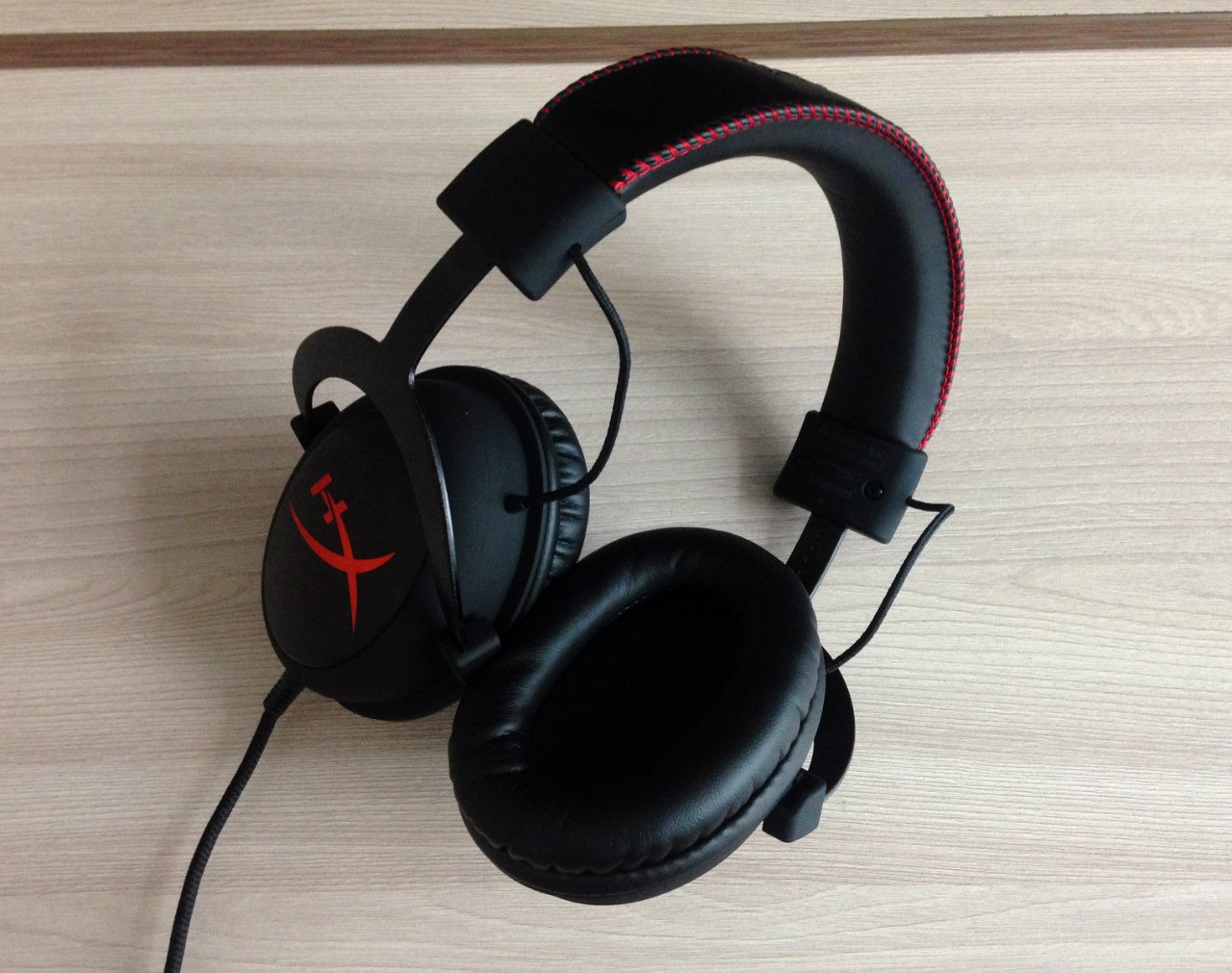
The cups are oval, the ear fits into them completely, the ear cups on the cups are made of leatherette and they are very, very soft to the touch. Inside the ear cushions there is soft foam, which is why the ear cushions take the shape of a head. Inside the headphone cups is a fabric mesh that is also designed to provide comfort when using headphones. The ear pads on the headphones are removable.
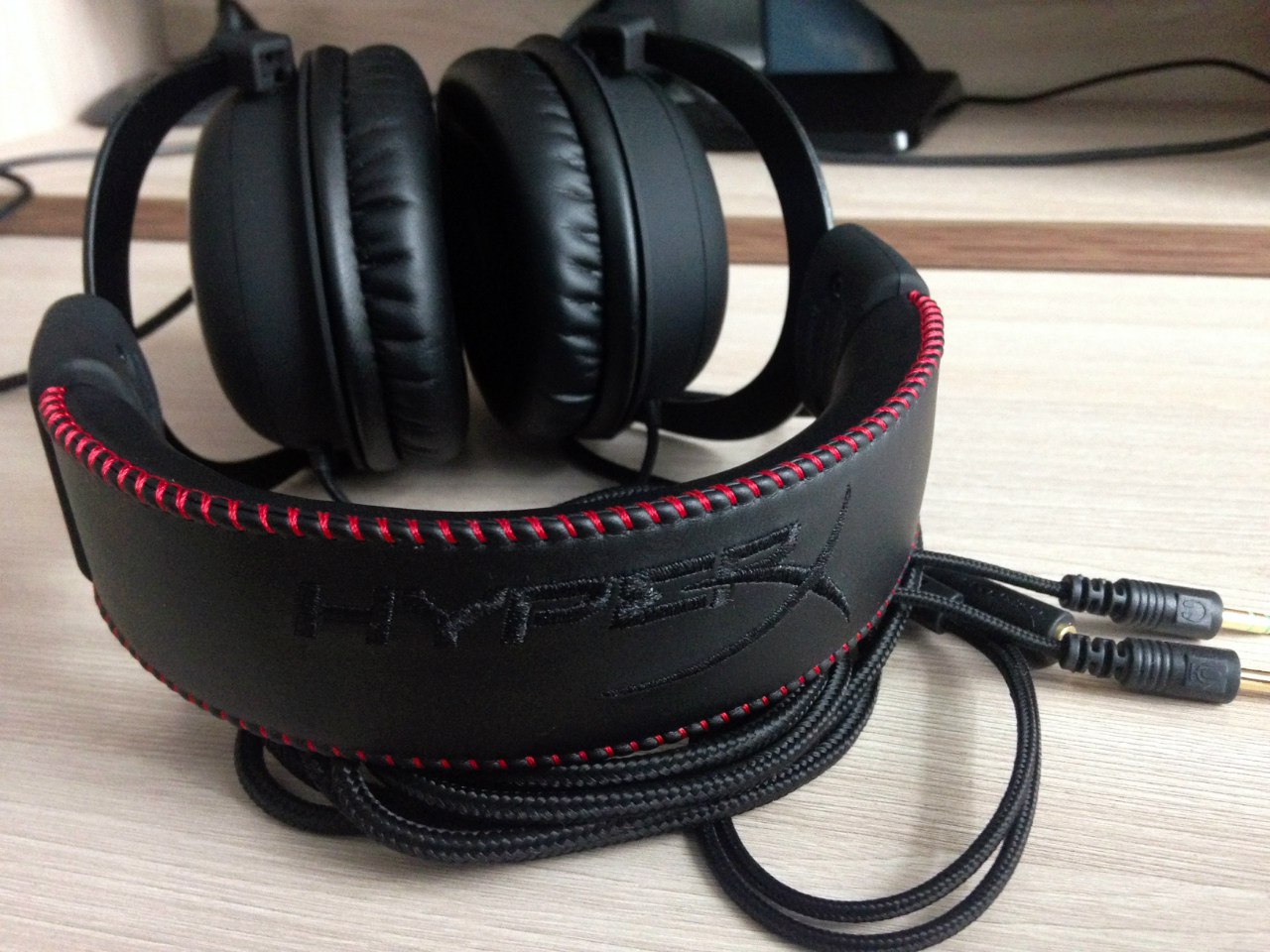
The headband is also very neat. It is soft, smooth, made of leatherette, it does not have the “wrinkles” that is often found with other headphones in various price categories. Purely visually looks nice. The headband is stitched with red thread, the stitching is very even. HyperX logo is embroidered with black thread on top of the headband.
Inside the headband is, as I understand it, an aluminum frame, which makes these headphones very reliable. The headband itself cannot be uncovered, so that if it is contaminated, it will have to be cleaned, and in general it should be handled carefully, since no replacement can be found.
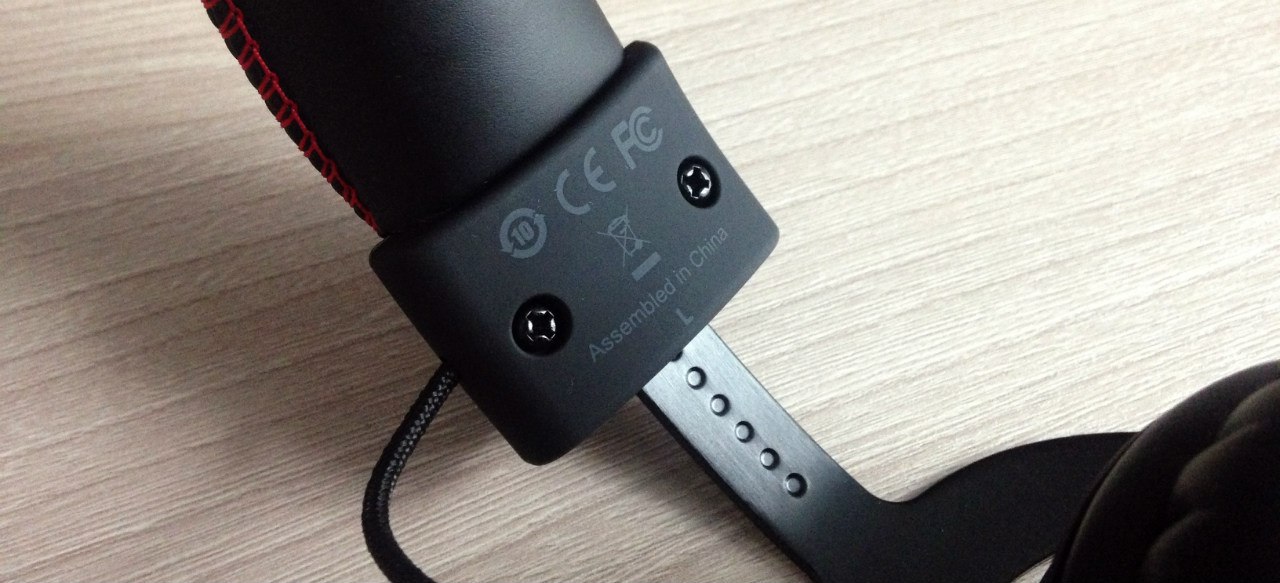
Near the cups, in the places of attachment, there are no details (usually they are made in the form of dots) that allow you to tactilely determine which side the left earphone is on. Although, in fairness, it is worth noting that the wire at the headphones is located on the left side, so that even in the dark you will not confuse which side to put on the headphones.
The wire enters on the left side, at the entrance and at the end it is protected from bending. The wire itself is quite soft and thick, in a fabric braid, while not very willing to remember the shape. The braid will not allow the wire to get tangled or bend too much. The cable length is 1.1 meters, at the end of a 4-pin 3.5 mm jack. An additional adapter is also braided, its length is 2 meters, at the end there is a 2x 3,5 mm jack: with a green mark for headphones and with a pink mark for a microphone. The maximum length is 3 meters with a small meter (take into account the plugs, which also give an extra ten centimeters). The wire connecting the ears (which goes from the left earphone to the right through the headband) ... is also braided. In general, all wires are braided.

Headphones sit comfortably, thanks to soft ear cushions they are practically not felt, and it is pleasant to the ears. They do not press on the head, but they do not teleport anywhere. The pressure on the head is almost imperceptible, so there are no problems. The headphones themselves are closed, with good noise isolation, so that most of the external noise will be cut off in them, so sometimes you can miss a call or someone else's call. But along with this, no one will hear what is now playing in the ears. Plus for those who like to sit at night, when others are already sleeping, for example.
Cups clearly follow their guides, each position is accompanied by a click, and for shaking your head, the headphones do not fly off, and the cups do not move anywhere. Of course, if you shake hard, they will fly off, but everything has its own measure. True, the headphone cups rotate only along the vertical axis (they have no movement along the horizontal axis), but even this does not interfere with a comfortable fit on the head.
Headphones are fairly lightweight (for monitor ears), so you can sit in them for hours. Moreover, when I got involved in something (shooting games or movies), I forgot that they are generally on my head. This, of course, is different for everyone, but for me the ears seemed almost weightless, and thanks to a good fit, nothing bothers anywhere. However, there is one unpleasant moment when you start scolding insufficient equipment: on a hot day or during a fierce fight, their ears sweat because leather substitute is used, and fabric or velor ear pads would be very useful here. But such, alas, are not available.
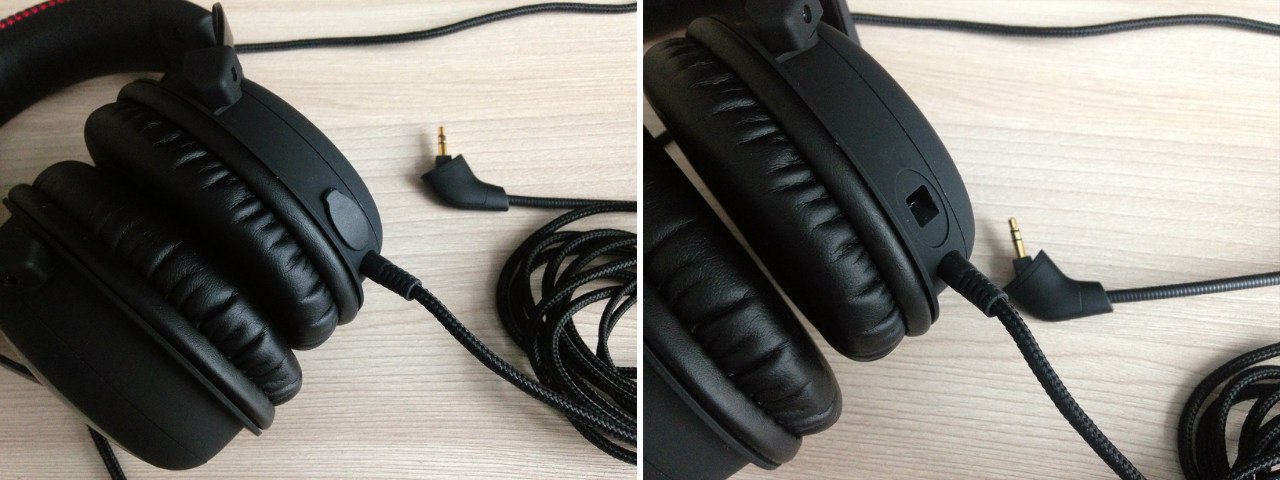
The microphone is connected at about the same place where the wire enters the left cup of the headphones, first you need to remove the plug. It’s hard to connect a blind microphone because it has a specific socket (that is, the connector is normal, but it’s hard to stick it in), so you have to remove the headphones when you connect the microphone. He also doesn’t clean up anywhere and always hangs in front of his mouth, so talking and drinking seagulls at the same time will not work, except to move him from his mouth at the risk of being inaudible to your interlocutor. And he does not turn off in any way. So if a
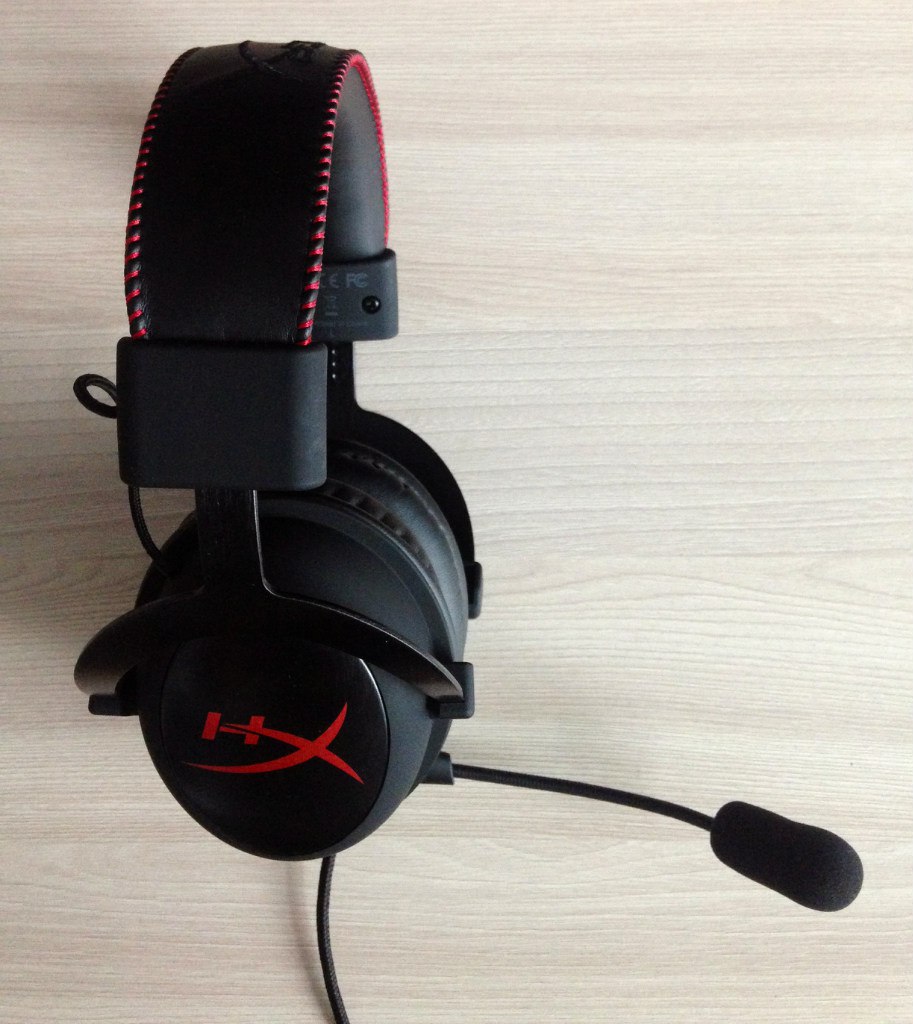
You cannot buy a microphone separately, so in the event of a breakdown or loss, you will most likely have no one to contact. At least, it is not yet possible to buy a microphone separately as a spare part. But, as the company itself said, such an opportunity is being considered , and given the growth in popularity, this would be very helpful. As well as the acquisition of the same ear pads, carrying bags and a set of various adapters and extension cords. Another thing is that our Chinese friends with AliExpress can order almost anything.
Headphones sometimes should be wiped off from dust, otherwise they are unpretentious in leaving. On painted aluminum and on the soft-touch coating there are practically no traces (only from very dirty or greasy hands), so from time to time they need to be wiped with a damp cloth, and they will look like new.
The design of the headphones is respected. Everything is very high-quality assembled and precisely fitted, visually the headphones look stylish and attractive, and most importantly, they sit comfortably on the head, do not put pressure on my ears, and I sat in them for hours on end. It’s nice to walk along the street with them. But, as you know, in any headphones the appearance is not as important as the sound, and therefore the most interesting part will be ahead.
And what about the sound? [ ↑ ]
Well, the headphones look beautiful, turn into a headset when installing a microphone, sit comfortably and generally ... In general, what about the sound? After all, headphones are taken, first of all, not for beauty, but for music, games and movies. And since they are positioned as a gaming headset, it should be understood that the emphasis here is on toys. But first things first.
Now and for the past few years I have been using Beyerdynamic DT 770 Pro 80 ohm headphones. It is clear that this is a completely different price category and the sound is different (but the nature of the sound, by the way, is somewhat similar), but at least it will be something to compare with.
Music
I love electronics and something heavy. Mostly electronics, so the compositions were in most cases fast, powerful and bass. There was also a place for vocals, and of course I will write about this. I’ll omit the moment of warming up the headphones, because this is an individual thing and, let's say, unreliable, so everyone will figure out whether the headphones were warm or not. I'll just talk about the sound.
Only music that I really like to listen to (and I often listen to) on my Beyerdynamic got into the tracklist. I listened to some of them for a very long time, and it was again pleasant to listen to these compositions. In any case, I heard all the features right away, besides the character of the sound from familiar compositions that sound different because of these headphones is easier to describe. I will not go into the names of the performers and indicate only genres. In each genre I chose at least 2-3 tracks (more is better) and this was enough, in my opinion, to assess the sound quality of the headphones. Genres: electro and progressive house, drum and bass, nude disco, psi-trans, glitch hop, trip hop, alternative rock, nude metal, chillout and dubstep.
Recording quality: mp3, (cbr, 320 kbps), flac / wav.
Sound Source:Asus Maximus VI Hero (Realtek ALC1150)
In short - the impressions of the sound are positive, and they only strengthened during listening to the material.
The headphones play quite smoothly, there are no serious biases or drops in frequency, but there are also some nuances here. I did not find the frequency response of these headphones, so I will describe the sound itself (I can’t do the frequency response myself). In general, the sound is very detailed, rich, rich, but it sounds a little “in the head,” that is, the scene is rather narrow. There is no sensation of a large stage, large space and surroundings around the listener. Some high and low stick out, and at first it was very noticeable, and then I slowly got used to it. But each rustle is more clearly audible, especially when it comes to live recordings. That is, breathing, moving your hand along the bar and other small noise details (even spurious ones) are very noticeable. In particular, the hissing and whistling sounds flying from the lips of the vocalists. As you understand, the higher the quality of the source records, all the better. The headphone volume is large, so lovers “louder” have room to take a walk.
In general, the sound does not reach the hi-fi equipment with a more or less decent source, but plays quite solidly, working out its price. I also recommend using any sound card (ZK) of at least a basic level, such as Asus Xonar DG / DGX (or slightly more expensive, like DX / DS / DSX - depending on the connection connector and required characteristics) to fully unlock the potential of the headphones.
I have a fairly simple criterion for good-sounding headphones: if when listening to music or any other audio material, nothing disturbs or distracts, nothing gets out of the overall volume level, then the headphones work as they should. Then you can describe it in so many words, take some criteria, but this is to some extent useless, because each of us perceives sound in our own way. I will say this: I believed the sound that HyperX Cloud produces. With some nuances, but it is. That is, after long listening, you are completely immersed in music and you don’t notice anything else around. And this indicates the level of the headphones.
Now, in a little more detail.
The bass sounds a little hollow, there is a “barrel” effect, but on the whole they play very well, although due to the close proximity of the speaker to the ears and the closed performance, there is a feeling that they stick out a little from the sound range. But they play powerfully, drive, there is no sense of swotting. For electronics and heavy compositions just right. Although, the definition of "resilient" also does not always suit them - I want a softer bass, more rounded, or something. I want a slightly longer duration of the “attack” to make the bass sound softer.
Next are the high frequencies. Not average, and in the next paragraph you will understand why. The top is perhaps the weakest part of these headphones. They in some cases act out sharply and quite noticeably stand out against the general background in some tracks / songs. In tracks, this manifests itself in the form of strongly-sounding cymbals (tts - tts - tts), in songs - in whistling and hissing (sss - tsss - hhh - ssch and similar sounds). If this is electronics, then there is a feeling of “sand” - the top in some tracks sound unassembled, as if scratching on the ears. You get used to it too, but at first it is noticeable. Remember what I said about warming up? Everyone will have their own opinion. Maybe it's in the headphones, or maybe in the habit.
Mid frequencies are played out smoothly, but they ... get a little lost against the general background, if the volume of bass / mid / top is the same. The top sticks out a little in the form of a "placer", the bass sounds powerful, but the middle ones - exactly. Without any embellishment and other things, but against the general background, they are sometimes lacking, the feeling that they have faded into the background somewhere and I want a little more. Moreover, this is typical for songs where there is vocals (no matter whose and what, but just where it is). In tracks without words, everything sounds pretty balanced. Another point: those instruments that have a wide range of playback - alt, violin, trumpet or saxophone (where mid and high frequencies are involved, for example) are played out a bit dryly, as for me. It does not catch if it is easier to say. Not all compositions, of course, but in some of them I didn’t like the sound of these instruments.
Detailed description of one composition
I remembered one of the compositions very well. I'm talking about the one that did not take the soul. Lee Dewyze - Blackbird Song. Have you watched the walking dead? Remember her? Not? Listen to this. The vocals here sound great, but the viola didn’t work out here. The instrument is “broadband”, therefore, accurate reproduction on the entire range is required, and it turned out to be somewhat sluggish, even. At some point, I described him as squeaky. There is no sensation of a living instrument, not hooked. When I listened to him on my baer, I got goosebumps. But not here, although I did not listen to this recording for a very long time and for the first time in a long time I turned them on with these headphones. Therefore, there are still moments with which the headphones can not cope.
Yes, precisely for the reason that I can describe each track in this way, I did not give all the examples, otherwise it would read 2 times longer.
Yes, precisely for the reason that I can describe each track in this way, I did not give all the examples, otherwise it would read 2 times longer.
So there is a feeling that in the frequency response the bias is made on the bottoms and tops, while the middle is a bit overwhelmed. However, I sin on the built-in sound (I do not have PCI slots on the motherboard, and therefore the only ZK that I had with a PCI connector, I could not install and check), so with a more or less decent source, I think these flaws will be removed or a little smoothed out.
Movies
I honestly sat 2 films. And I did not notice how I sat them. I did not remove the headphones and was completely immersed in what was happening. At the same time, I looked at something that my hands did not reach. It is noteworthy that all the knocking sounds that I noticed in the process of picky listening did not show themselves here. The bass sounded, everything clanged, and it even seemed more like a very accurate detail than a flaw, the sounds breaking out of the picture. The whole sound only created an atmosphere. That is, where very high frequencies are not used, the headphones do just fine. And the general feeling of comfort from the ears themselves made it possible to forget about reality.
Games
Indeed, HyperX Cloud is positioned as a headset, and precisely as a gaming headset, and therefore testing without games would be inferior. And, of course, the answer to the main question of the counter-strikers will be announced: “Are steps heard?” The
audio track in games plays well. Moreover, those features that I found fault with in music, in games sound "as they should." Surprisingly. So nothing sticks out anywhere, and the speakers located close to the ears allow you to hear absolutely all the details. The headphone positioning is excellent, you immediately turn your head to where you heard some rustling. A well-implemented (spatial) stereo in shooting games gives a complete picture of what is happening in the game world.
“But this is a headset!” You say. Right. The headset reveals its full potential in terms of listening and communication, where the outcome of the battle depends on the operatively transmitted information. Since all steps are audible in the ears and the picture of the battle clearly appears, when you hear what, where and where, the reaction to all these actions will be immediate. And if by the sound she loses to my headphones (baers), then as a headset she has a huge advantage.
In CS GO you hear all the subtleties that you can hear, so the sound here is on your side. Again, the character of the sound is the same as when listening to music: a slight effect of the barrel from low frequencies is felt and at first shots come out too much into the foreground, especially their high frequencies (if you shoot from Avik, you’ll understand what this is about). But at the same time, the sound in the game sounds juicy and at the slightest rustle you turn your head (in the game) in the direction from which this rustle came. And most importantly - a complete immersion in the game, when nothing else exists around.
The headset does not support spatial sound - 7.1. And is he needed? I definitely think not. A good, high-quality stereo will do much more than virtual 7.1-mode (which, by the way, was in HyperX Cloud II - virtual sound 7.1 gave a sound card from the kit). Everything sounds great in films, and the same 5.1 soundtracks in films give excellent positioning. The stereo also plays perfectly, so there is no need for multichannel sound. A serious advantage will be headphones that have real 5.1 and 7.1 sound (in which many speakers are stuck), but their cost is very high. And they are not omnivorous, moreover. Music in such headphones will sound worse.
Portable use
“ Darling, why can you hear so well?”
- Honey, I'm just using the Kingston HyperX Cloud headset.
I did not expect this from the headphones, but they ... are great at playing on mobile devices. My source of sound was the iPhone 5C. And its built-in sound module was enough to swing HyperX Cloud Core. The sound, of course, turned out to be worse than from a computer, which was expected, but the fact of using them as a portable headset says a lot.
At the same time, she conveys a voice no worse. The headset works fine in Skype, and in Facetime, and in ordinary conversations. Although there is no answer button on it, as on complete earbuds, it is still much more convenient to talk through it, rather than leaning the phone against your ear. Firstly, I heard everything perfectly and I was not disturbed by any extraneous sounds. Secondly, I can hear well. Thirdly, it’s just convenient. Although on the street I looked probably strange :) Well, that bothers me a little. In those cases when it is necessary to hear the interlocutor, the headset proved to be the best. Honestly, I was pleasantly surprised by this.
When you connect headphones to the phone jack without connecting a microphone, they work just like headphones (that is, you had to speak into the microphone located on the phone), and when you connect the microphone to the headphones, all voice was transmitted through the connected microphone. Another point that I noticed: when I connected the microphone, the overall volume level in the headphones sagged a little. Nevertheless, the headset's volume margin even in this case is quite impressive. I had half the volume from the maximum to comfortably listen to music.
Microphone testing
And a couple of samples for a snack. Just a minute recording with my monologue to evaluate the microphone.
The first is recording from a computer in * .wav format. I understand that for a microphone of this level it is bold, but "as is". Recorded using Adobe Audition. For recording, I used the microphone gain +30.0 Db, otherwise I can hardly hear from it. In general, I recommend using ZK and gain equal to +10 or +20 Db. That is why noises are heard on my recording.
Download sample (stereo, 16 bit, 44100 Hz, 13 MB).
Second - recording when connected to iPhone 5C in * .m4a format.
Download sample (stereo, 16 bit, 44100 Hz, 420 KB)
Headset Impressions [ ↑ ]
The headset is extremely versatile. She looks stylish, sits comfortably on her head, sounds good and clearly conveys the most important thing - the voice. She has good sound insulation and does not put pressure on her head. And in portable use, the headset proved to be the best. Agree, leaning back in the chair and talking freely is better than pulling a microphone to you separately. Impressions of the sound are only positive, even despite some flaws in the reproduction. You get used to it and it gives pleasure. However, in my opinion, it is advisable to use at least an entry-level ZK with such headphones.
This is the youngest model in the HyperX Cloud line, but at the same time it removed everything superfluous, leaving the most important thing unchanged - the sound. Therefore, only the equipment was damaged, with which, in general, you can put up with. For some, this option would be even preferable. True, it turned out that in the lineup there are now 3 models of headsets with similar sound (and most likely with the same one - I did not listen to other headsets in the lineup), so you should choose based on the price and the required equipment. Yes, the equipment on this headset is more than modest, but it contains everything you need: headphones, a microphone, an adapter. Someone does not need more.
In my opinion, taking these headphones purely for music is probably not the best solution. But as a headset, it has undoubted advantages. If by sound they lose the same Beyerdynamic, then in games everything is heard very clearly, and besides, there is excellent communication. And if you consider that not everyone needs a studio-grade headphone when you spend more time in games or you don’t care about the high sound quality, you should pay attention to this headset. The result is a headset with a gaming focus on which music is adequately reproduced.
The issue price is about 5000 rubles. Perhaps more, given the current dollar. A good option for reasonable money.
Pros:
- Assembly
- Materials
- Appearance
- Comfort fit
- Comfort for extended use
- Detachable microphone
Minuses:
- Equipment
- Fixed cable
Features:
- Sound
- Length of cable
- Ear pads
